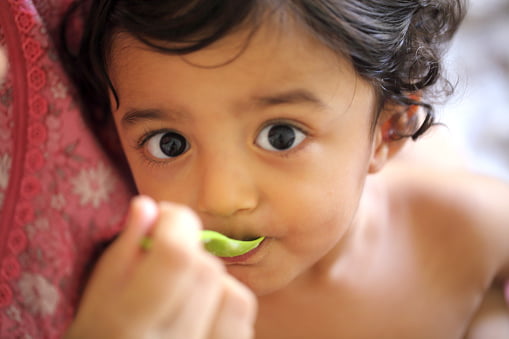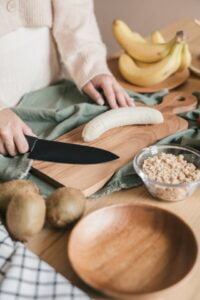One Year Old Baby Food: Feeding Schedule
- Published on:
- Last update: 13 November 2023

First Year Feeding Schedule for Babies
After sharing the photos of your messy-mouthed munchkin’s first meal milestone and snapping the pictures of his messy mouth, you’re wondering where to go next. One year old baby food is a great milestone in feeding babies.
When should your child begin eating three meals a day, and how much solid food should they have each day? What is the proper ratio between solids and breast milk?
When And How Often Should I Feed My Baby Solids?
There is no one “perfect” time of day to feed your baby – you should do whatever works best for you. Your milk supply may be at its lowest rate in the afternoon or early in the evening if you’re breastfeeding. However, babies who wake up bright-eyed and eager may be eager to try solid food for breakfast.
During teething, you will quickly learn when your baby is interested in eating versus when she isn’t, which will be evident by the fact that she will open her mouth wide and take bites or will palm and gum finger foods on her own versus fussily turning her head away. It is best not to overfeed and to follow the cues. If need be, you can always start again later.
One year old baby food, start with one meal, then switch to two. Try to eat one in the morning and one in the evening. Once your baby reaches toddlerhood, you can work up to three solid meals per day, interspersed with one or two snacks.

What Is The Recommended Amount Of Food To Feed My Baby In One Sitting?
Whenever you’re trying to figure out just how much to offer your little one at each meal, it’s a good rule of thumb to start small and build up. Start small when it comes to one year old baby food.
Your baby’s first meals might have consisted of a teaspoon or two of solid food, but once she gets the hang of eating, you can use the following baby feeding chart as a general guideline.
4 To 6 Months:
- Five to eight nursing sessions a day, or 24 to 36 ounces of formula or milk.
- Once or twice a day, 1 to 4 tablespoons of cereal
- A serving of fruit or vegetable once or twice a day
6 To 8 Months:
- Since your baby is more accustomed to nursing, you’ll probably breastfeed him/her four to six times a day with 24 to 36 ounces of formula or breast milk.
- Four to nine tablespoons of cereal, fruit, and vegetables a day, spread over two to three meals
- Daily intake of 1 to 6 tablespoons of meat or other protein such as yogurt, cottage cheese, or crumbled eggs
9 to 12 Months:
- Three to five nursing sessions or 16 to 30 ounces of formula or milk per day.
- Twice a day, around 1/4 to 1/2 cup of grains, fruit, and vegetables
- An average of 1/4 to 1/2 cup of dairy products per day
- Approximately 1/4 to 1/2 cup of protein-rich foods a day

What Is The Best Way To Determine The Portion Size Of Baby Food?
While serving size guidelines can be helpful, it’s important to remember that every baby is different from the next. When your little eater eats one day and even has seconds or thirds, and then clamps her tiny mouth shut the next, it’s perfectly normal.
Please try not to be alarmed if your cutie’s appetite isn’t always the same or if the food she chooses to eat doesn’t quite match the recommended servings. Include nutrient rich ingredients in one year old baby food.
Trying to force your baby to eat when she doesn’t want to isn’t fun for either of you, and it can make it harder for her to recognize her body’s natural hunger and fullness cues.
Rather, let your child choose a variety of nutrient-rich foods in age-appropriate portions and let them handle the rest. Despite her body’s demands, your new nosher can take in what she needs.
Providing her with balanced options will, most likely, allow her to get everything she needs over the course of the day or week.
However, what about on the other hand? You should trust your instincts. You should speak with your pediatrician if you suspect your baby has a feeding problem, feels uncomfortable or fussy after eating, or doesn’t seem to be gaining weight as she should. By working together, you can resolve any issues and make mealtime more enjoyable.
When I Introduce Solids, How Do I Incorporate Breastfeeding Or Bottle-Feeding?
You are still providing the majority of your baby’s nutrition with breast milk or formula, even if he or she is sucking on a spoon or learning to gum at finger foods as you are switching to a baby-led weaning approach. You can view the solid food you serve at first as healthy supplements and as an opportunity for your sweetie to explore new tastes and textures.
What’s the right time to serve solids and when should you serve a bottle or breast? The answer is there isn’t a definitive answer. It’s often a good idea to start off a meal with breast milk or formula as an appetizer so your little one isn’t too hungry when you sit them down to eat.
As a first course, some parents offer solids, followed by breast milk or formula for dessert. Then there are parents who prefer to completely separate solid food from feeding or nursing sessions. Try to follow the baby’s lead when it comes to one year old baby food.
It’s a good idea to experiment until you find a feeding schedule that works for you since there is no hard and fast rule. Include healthy items in one year old baby food.
A Sample Feeding Schedule For A Baby
During your baby’s first days eating solids, you should focus on helping her get used to family mealtimes. In an ideal situation, she should eat when everyone else is present at the table.
If your baby is still receiving the bulk of her nutrition from breast milk or formula until she is one year old, those liquid meals should still be the priority. Prepare healthy one year old baby food.
If you’ve never fasted before, you can start with just one or two solid meals per day, whichever is most convenient for you.
For example, if your cutie is in daycare and you want the honor of feeding her solid food, provide breakfast and dinner. It may be difficult to squeeze in dinner before her nighttime milk feeding, so take her to breakfast and lunch during the day.
You can transition to three meals once your baby is 8 or 9 months and eating a variety of foods and only taking a morning and afternoon nap in the afternoon, which means more free time in the day. Include tasty and healthy one year old baby food to make the transition easier.
Please remember that every baby and every family is different, so these sample schedules can help you visualize how solids fit into your baby’s day. The schedule of your baby may not be predictable or consistent until she turns two.
Sample Feeding Schedule For A 4- To 6-Month-Old Baby
In this schedule, naps are assumed to be three for a 4- to 6-month-old, though some 6-month-olds may drop to two, and you will introduce solid foods by spoon-feeding purees.
If you are following a baby-led weaning approach, you wouldn’t introduce solids in the form of soft, gummy finger foods until your child is at least 6 months old, when he/she is more likely to be capable of self-feeding.
Remember These Points
Depending on the infant’s development, introduce solid foods around 6 months of age. Typically, infants can eat solid foods when they are able to:
- Sit up on their own or with a little assistance
- Put things in their mouths when they reach for them
- Open their mouth when they see something coming
- Eat their food rather than pushing it out of their mouths
- Move food with their tongues to the back of their mouth
- Turn their heads when they don’t want something
Introducing solid foods should be done in a calm environment where the infant is sitting upright, properly supported, and moderately hungry. You can try Yummy Valley’s healthy baby food for one year olds.
Share this post:

